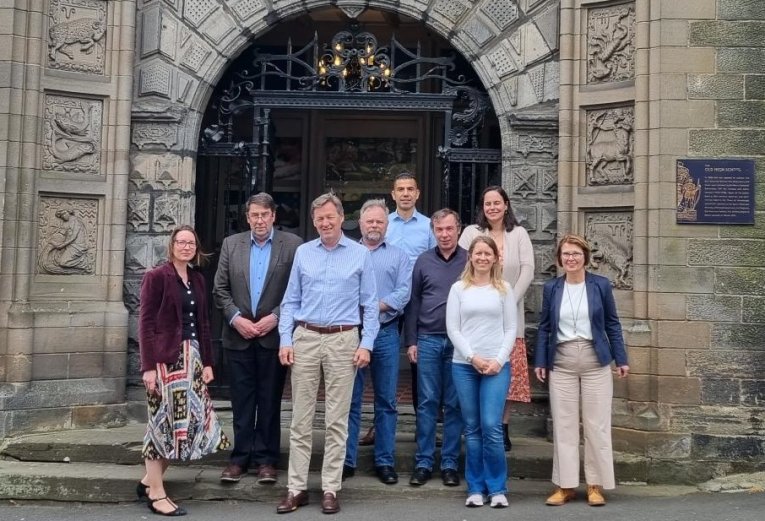On 31st May 2023, IFFO hosted a technical workshop in Stirling, Scotland to explore a range of critical questions around omega-3 futures in aquafeeds. Where are the existing stocks of EPA and DHA being used now? How are we valuing EPA and DHA? What new resources are out there and where is the realistic growth potential? What are our estimates of requirements for EPA and DHA by aquaculture species? How can we more effectively quantify the benefits that EPA and DHA bring? What can we learn from Human and Biomedical research?

Fish oils can be up to one third made up omega-3s. Most crude oils for omega-3 products come from small pelagic fish like anchovies and sardines, and increasingly from by-products from the seafood industry. In 2022, 54% of global fish oil production was made from using fish by-products. Up to 25% of global EPA and DHA production is from Peru, making this producing region very influential in global trade dynamcs. Global production of fish oil has been remarkably stable over the last decade at around 1.2 million metric tonnes a year on average, up to this year. The value of fish oil has seen quite a few changes in the last 12 to 18 months. The recent “La Niña events explains the drop in EPA and DHA production in 2022” IFFO’s Enrico Bachis, Market Research Director, explained, adding that in addition to El Niño events, the counter-event of La Niña greatly influences the overall fat content in fish.
As for demand, there’s never a shortage of it; with three sectors are driving this demand: aquaculture (with more than 70% of fish oil usage), pharmaceuticals and pet food.
Growing needs
As populations become more affluent, they demand better quality food that requires more resources. China per capita seafood consumption almost doubled between 2005 and 2015 (26.1kg to 41Kg – Source: FAO 2018).
“There is a lot of inefficiencies in the value chain for most species, although in aquaculture, gains are being made in terms of nutrition, feed delivery and genetics, for some species. Only a small fraction of EPA and DHA from net fish production is actually harvested: seafood trimmings have huge uncaptured value.” Richard Newton, Lecturer in Resilient Food Systems in Institute of Aquaculture, (University of Stirling) stated. “There is a push to apply a nutritional index to life cycle assessment as an additional impact category” he added: “A big topic presently is how to measure the impacts of food from a nutritional perspective”.
Requirements and benefits
Based on several decades of science, it is well established that EPA and DHA have a wide range of effects both on fish and human physiology: cell membrane structure, regulation of inflammation and disease resistance. “Attention needs to be paid to the EPA / DHA ratio, the overall EPA and DHA amount, n-6/n-3 ratio” insisted Nina Liland, Researcher at IMR Norway. “EPA and DHA influence how cells work (via both membrane function and gene expression). The physical structure of cell membranes change and critically the membrane enables the proteins alter or regulate their function” Philip Calder, Professor of Nutritional Immunology at the Faculty of Medicine (University of Southampton, UK) explained.
Looking to different species, IFFO’s Technical Director Brett Glencross stated that it is difficult to pool marine fish species together and how they respond to EPA and DHA. Requirements change with fish size: higher requirements are needed at a young age. Only few quantitative models on maximising uptake and retention efficiency are available for a few species, and further work is needed in this area to develop more optimal management strategies for omega-3 optimisation.
NOFIMA’s Bente Ruyter, Senior Scientist, looked into omega3 nutritional requirement in salmon, reporting on a research project focusing on the impacts on growth, quality and health. She reported that an intake of 6.5% to 10% of EPA and DHA in the fat in feeds fed to fish in sea cages is needed to impact growth and quality positively. Whereas an intake of 3% to 10% is needed to impact health positively, depending on tissue, life stage and degree of stress and environment.
As for shrimp, they don’t store lipids like fish do and are not considered a useful source for omega-3 intake by humans. “Shrimp don’t tolerate high lipid levels. Digestion of lipids is affected by lipids levels and fatty acid profiles” Dr Brett Glencross highlighted. Shrimp need dietary omega3 fatty acids: research has demonstrated that absence of lipids and omega-3 is terminal. A combination of short chain and long chain PUFA is better than either alone, with this effect evident in multiple shrimp species.
Novel omega-3 sources
Moving on to novel omega3 resources, Monica Betancor, Associate Professor in Institute of Aquaculture (University of Stirling, UK) reported that each of them presents a range of benefits and risks:
- indoor vertical farming of microalgae (primary producers of EPA and DHA) can be used to feed fish both at larvae and adult stages. However, the use of microalgal biomass directly in feeds limits inclusion, due to digestibility issues, and price has been a barrier especially for algal oil.
- GM-crops have been produced that include microalgal genes , and are now capable of producing their own EPA and DHA. But legislation and deregulation in certain countries has been are limiting and public acceptance is low at present (in some markets).









